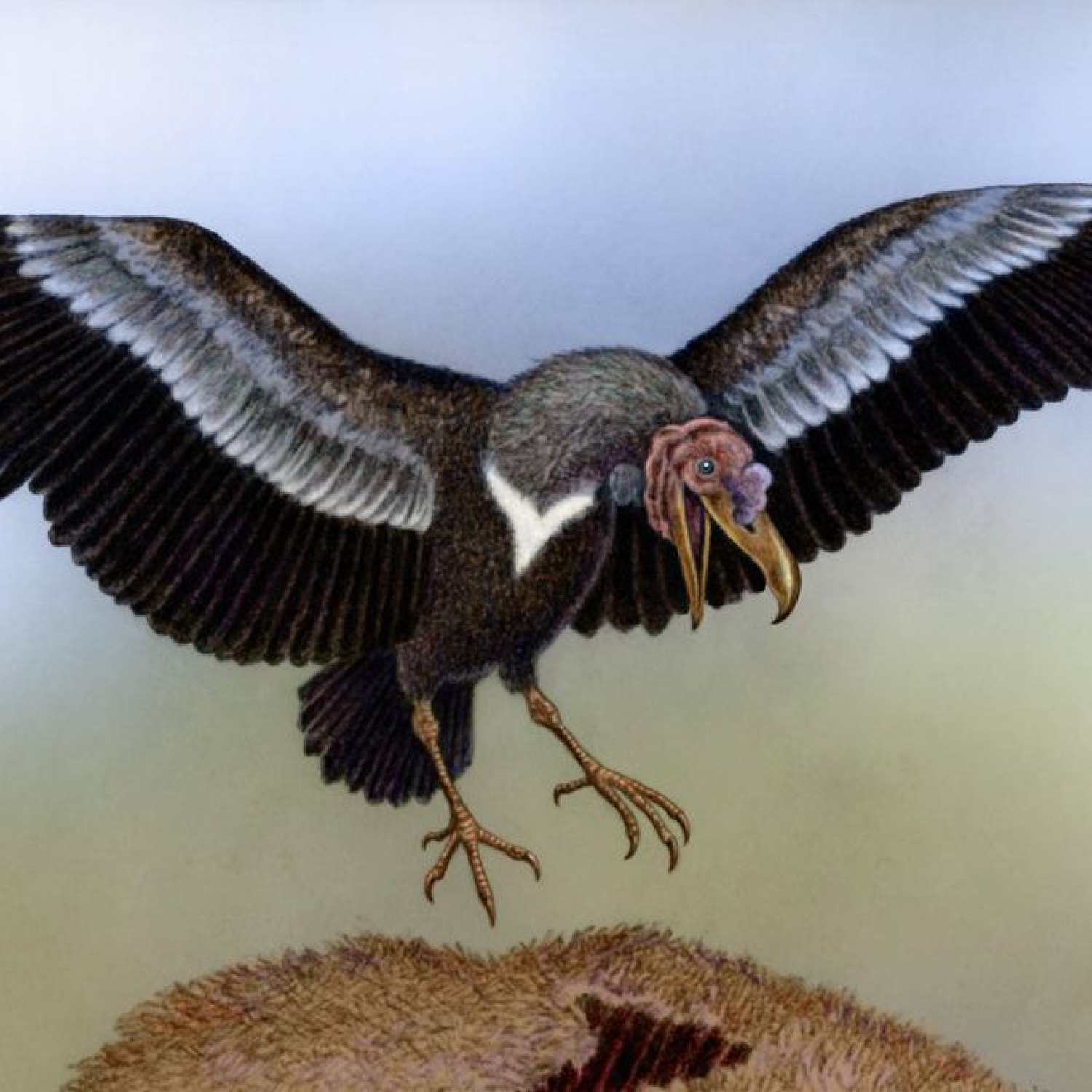
Argentavis Magnificens
6 meters
The Argentavis Magnificens, also known as the 'Magnificent Argentine bird', was a massive flying creature that lived around 6 million years ago. With a wingspan of 6 meters, it was larger than any bird alive today. Fossil remains of this impressive avian have been discovered in Argentina, earning it its scientific name. Its family, the Teratornithidae, consisted of other large and bird-like creatures. Imagine seeing one of these majestic birds soaring through the skies!
Animal Details Summary:
Common Name: Argentavis
Kingdom: Animalia
Habitat: Open grasslands and woodlands
The Enormous Argentavis: A Magnificent Flying Giant of South America
The Animal Kingdom is filled with fascinating creatures that range in size, shape, color, and abilities. From the tiniest insect to the largest animal on earth, each has its unique characteristics that make them stand out. One such creature is the Argentavis Magnificens or simply known as Argentavis, a magnificent flying giant that roamed the skies of South America during the Miocene era. With a wingspan of 6 meters, this massive bird was an apex predator in its habitat and has left a lasting impression in the world of paleontology Argentavis Magnificens.The Argentavis belongs to the kingdom Animalia, the phylum Chordata, and the class Aves, which means it is a large bird. However, what sets it apart from other birds is that it belongs to the order Teratornithidae, a group of giant birds that are now extinct. This unique classification gives us an idea of just how impressive this flying giant was.
The Argentavis Family: Teratornithidae
The Teratornithidae family was known for its massive birds with a wingspan of over 3 meters and a body weight of over 80 kilograms. They were the giant rulers of the sky, soaring through the open grasslands and woodlands of South America. This family of birds is believed to have originated around 23 million years ago and went extinct approximately 1.8 million years ago.The Argentavis was the largest and most well-known member of the Teratornithidae family. Due to its impressive size and predatory nature, it was nicknamed the "Giant Terror Bird Aussiedor." However, despite its terrifying name, the Argentavis was a bird and not related to actual terror birds that existed during the same period.
The Habitat and Diet of the Argentavis
The Argentavis was native to South America, particularly in the country of Argentina, where fossils have been found. They inhabited open grasslands and woodlands, making it easier for them to hunt for prey. With their massive size and powerful wings, they could fly for days without rest, covering vast distances in search of food.As a carnivorous animal, the Argentavis had a varied diet. They were apex predators, which means they were at the top of the food chain. Fossils have shown that they preyed on a variety of animals, including small mammals, reptiles, and other birds. They were also known to scavenge for food, making them opportunistic hunters.
The Appearance of the Argentavis
Many paleontologists believe that the Argentavis looked like a modern-day eagle, but much larger. They had a black coloration, with a body shape similar to that of a bird, but with a few unique characteristics. With its long, powerful beak and sharp claws, the Argentavis was a fearsome sight to behold.One of the most significant features of the Argentavis was its wingspan. With a wingspan of 6 meters, it was the largest bird to have ever existed, surpassing even the Andean condor. Its massive wings were essential for flight, allowing it to soar and glide for long periods without flapping its wings.
The Argentavis: A Fascinating Discovery
The Argentavis was first discovered in the late 1970s in Argentina by two researchers, Kenneth Campbell and Edward F. Huey. They came upon a massive bone fragment that they believed belonged to a bird. However, it wasn't until 1983, when the fossil was fully assembled, that they realized the significance of their discovery. Further excavations revealed more fossils, including a complete skull, which helped paleontologists understand the anatomy of the Argentavis better.The Significance of the Argentavis in Paleoecology
The discovery of the Argentavis has had a significant impact on the field of paleontology. It was the first time a complete skeleton of a giant bird of prey was found, giving researchers a better understanding of their anatomy and behavior. Its existence also raises intriguing questions about the environment and ecosystem of South America during the Miocene era. With its giant size and predatory nature, it is believed that the Argentavis played a crucial role in controlling the population of smaller animals in its habitat.Moreover, the Argentavis has also helped scientists better understand the process of evolution. By studying its fossils and comparing them with other giant birds, such as the Andean condor, they can identify patterns and changes in size, behavior, and feeding methods. This has given us a glimpse into the evolution of birds and how they have adapted to their environment over millions of years.
The Argentavis: A Tribute to its Greatness
The Argentavis may have gone extinct over a million years ago, but its legacy lives on. Its impressive size and predatory nature have made it a staple in popular culture, appearing in various forms of media such as documentaries, books, and even video games. Its fossils are displayed in museums around the world, giving people a chance to marvel at its greatness.There have also been efforts to create replicas of the Argentavis, showcasing its size and appearance. In 2014, a team from the Smithsonian Institution created a life-size replica of this magnificent bird. It stands tall and proud in the National Museum of Natural History in Washington D.C., a testament to its greatness.
The Final Flight of the Argentavis
The Argentavis may have been a giant in the sky, but its reign was short-lived. It is believed that changes in the environment and climate led to its eventual extinction. However, its legacy and impact on our understanding of the Animal Kingdom continue to soar.In conclusion, the Argentavis Magnificens was indeed a magnificent creature. From its immense size to its predatory nature, it was an extraordinary animal that roamed the skies of South America. While it may be gone, its significance and greatness will continue to inspire fascination and awe for generations to come.

Argentavis Magnificens
Animal Details Argentavis Magnificens - Scientific Name: Argentavis magnificens
- Category: Animals A
- Scientific Name: Argentavis magnificens
- Common Name: Argentavis
- Kingdom: Animalia
- Phylum: Chordata
- Class: Aves
- Order: Teratornithidae
- Family: Teratornithidae
- Habitat: Open grasslands and woodlands
- Feeding Method: Carnivore
- Geographical Distribution: South America
- Country of Origin: Argentina
- Location: Fossils found in Argentina
- Animal Coloration: Black
- Body Shape: Large and bird-like
- Length: 6 meters

Argentavis
- Adult Size: Wingspan of up to 8 meters
- Average Lifespan: Unknown
- Reproduction: Egg-laying
- Reproductive Behavior: Unknown
- Sound or Call: Unknown
- Migration Pattern: Unknown
- Social Groups: Unknown
- Behavior: Thought to be a soaring bird
- Threats: Extinct
- Conservation Status: Extinct
- Impact on Ecosystem: Unknown
- Human Use: None
- Distinctive Features: Giant size and bird-like appearance
- Interesting Facts: One of the largest flying birds that ever existed
- Predator: Unknown

Argentavis magnificens
The Magnificent Flight of Argentavis Magnificens: The Extinct Giant Bird
In the past, our planet was home to some incredible creatures. From colossal land mammals to massive marine reptiles, the Earth's history is filled with awe-inspiring animals. Among them was the Argentavis Magnificens - a truly remarkable creature that soared the skies with its impressive wingspan.The Argentavis Magnificens, also known as the Magnificent Argentavis or simply Argentavis, was a species of giant bird that lived in the Miocene epoch approximately 6 million years ago PeaceOfAnimals.Com. This fascinating creature was native to South America, specifically in what is now Argentina. The name "Argentavis" comes from the Latin word "argentum," which means silver, and "Magnificens" which means magnificent. Together, it translates to "magnificent silver bird," a fitting name for this giant avian.
One look at the Argentavis and it's easy to see why it was given such a grand name. This bird was truly massive, with an adult size that could rival even the largest flying birds of today. With a wingspan of up to 8 meters, this extinct bird was one of the largest to ever take flight, making it a truly magnificent and majestic sight.
Despite its impressive size, not much is known about the Argentavis Magnificens. Due to its extinction, scientists are limited to what they can learn about this fascinating creature through fossil evidence. However, with what has been discovered, we can still paint an intriguing picture of this remarkable bird Achrioptera Manga.
Adult Size: Wingspan of Up to 8 Meters
The most defining feature of the Argentavis Magnificens was its immense size. With a wingspan of up to 8 meters, it was almost as tall as a giraffe and could easily dwarf a human. This massive size was a result of the bird's adaptation to its environment and way of life.
The Argentavis was a soaring bird, meaning it would use thermals and air currents to glide through the air, conserving energy while soaring for hours on end. Its large wingspan was an essential part of its flying abilities, allowing it to catch and ride the wind with ease. With this remarkable wingspan, the Argentavis would have been able to soar quietly and gracefully across the sky.
Average Lifespan: Unknown
As the Argentavis Magnificens lived millions of years ago, it's challenging to determine its average lifespan accurately. However, the average lifespan of similar birds gives us a rough estimate of how long the Argentavis may have lived. Birds like the Andean Condor, which have similarities in terms of size and flying habits, can live up to 70 years in captivity. Based on this, it's reasonable to believe that the Argentavis could live a similar, if not longer, lifespan.
Reproduction: Egg-Laying
One notable aspect of the Argentavis Magnificens is its reproductive method. Like most birds, this creature laid eggs to reproduce. However, due to its enormous size, it's believed that the Argentavis laid only a single egg at a time. This is a common occurrence among large birds, as caring for more than one offspring at a time would be a significant strain on their energy and resources.
Reproductive Behavior: Unknown
Unfortunately, not much is known about the reproductive behavior of the Argentavis. As they were discovered relatively recently, scientists have not found enough evidence to determine how these birds behaved during the breeding season. It's possible that the males may have displayed elaborate courtship rituals to attract females, but without concrete evidence, it remains a mystery.
Sound or Call: Unknown
Similar to the reproductive behavior, the sound or call of the Argentavis Magnificens is unknown. As birds use vocalizations to communicate with their partners and offspring, it's possible that the Argentavis had distinct calls for various purposes. Sadly, without access to a living specimen, we may never know for sure.
Migration Pattern: Unknown
Another aspect of the Argentavis' behavior that remains a mystery is its migration patterns. Many birds, especially those with large wingspans, migrate to different regions during different seasons to avoid harsh weather conditions and find plentiful food sources. It's possible that the Argentavis may have had a similar pattern, but again, we lack evidence to confirm this.
Social Groups: Unknown
It's difficult to determine if the Argentavis Magnificens lived in social groups, as fossil evidence cannot provide this information. Some researchers suggest that they may have lived in pairs or small family groups, similar to modern-day eagles and vultures. Others suggest that they may have been solitary creatures, coming together only during the breeding season. However, without concrete evidence, we can only speculate.
Behavior: Thought to be a Soaring Bird
The behavior of the Argentavis was likely similar to other large soaring birds, such as the Andean Condor and the California Condor. These birds have been observed using thermals and updrafts to soar for hours at a time, barely flapping their wings. It's believed that the Argentavis may have also used this method of flying, allowing them to conserve energy and travel long distances with ease.
Threats: Extinct
Sadly, the Argentavis Magnificens no longer exists. This giant bird went extinct around 6 million years ago, along with many other species during the Miocene extinction event. The exact cause of their extinction is still unknown, but it's believed that changes in climate and environment, as well as competition with other species, may have been contributing factors.
Conservation Status: Extinct
Due to its extinction, the Argentavis Magnificens is considered an extinct species. Its disappearance from the planet is a loss to the natural world, and a reminder of the fragile state of our environment. The extinction of the Argentavis and other species can serve as a cautionary tale, reminding us of the importance of conservation and preservation of our planet's diverse creatures.
Impact on Ecosystem: Unknown
As little is known about the behavior and diet of the Argentavis, it's challenging to determine its impact on the ecosystem. However, as with any species, it's likely that they played a crucial role in their environment. They may have acted as scavengers, helping to clean up carcasses and prevent the spread of disease. The disappearance of the Argentavis and other species may have had a ripple effect on the ecosystem, leading to changes in biodiversity and functioning.
Human Use: None
Unlike many other animals, the Argentavis Magnificens had no known use for humans. As they lived millions of years ago, they were not hunted for food, nor were they used for any other purpose. They simply lived their lives in the skies, soaring majestically above the Earth.
Distinctive Features: Giant Size and Bird-Like Appearance
As mentioned earlier, the most notable features of the Argentavis were its tremendous size and bird-like appearance. With its enormous wingspan and graceful flight, it was a sight to behold. It had a long, slender neck, a sharp beak, and talons for grasping prey. Its feathered wings and body gave it a sleek and elegant appearance, resembling modern-day birds of prey.
Interesting Facts: One of the Largest Flying Birds That Ever Existed
One of the most astonishing facts about the Argentavis Magnificens is that it was one of the largest flying birds to ever exist. In fact, it may have been the heaviest bird to ever take flight. Its existence was truly remarkable, and it serves as a reminder of the incredible diversity of life that has graced our planet.
Predator: Unknown
The Argentavis Magnificens was likely an apex predator, meaning it had no natural predators. Its massive size and powerful wings would have made it difficult for any other animal to hunt. However, as mentioned earlier, competition with other species and changes in the environment may have contributed to its extinction.
The Argentavis Magnificens may no longer soar in our skies, but its legacy lives on in the fossil records and our imaginations. It's a reminder of the incredible creatures that have inhabited our planet and the need to protect the delicate balance of our ecosystem. The Magnificent Argentavis may be extinct, but its memory will continue to inspire and captivate us for generations to come.

The Enormous Argentavis: A Magnificent Flying Giant of South America
Disclaimer: The content provided is for informational purposes only. We cannot guarantee the accuracy of the information on this page 100%. All information provided here may change without prior notice.












